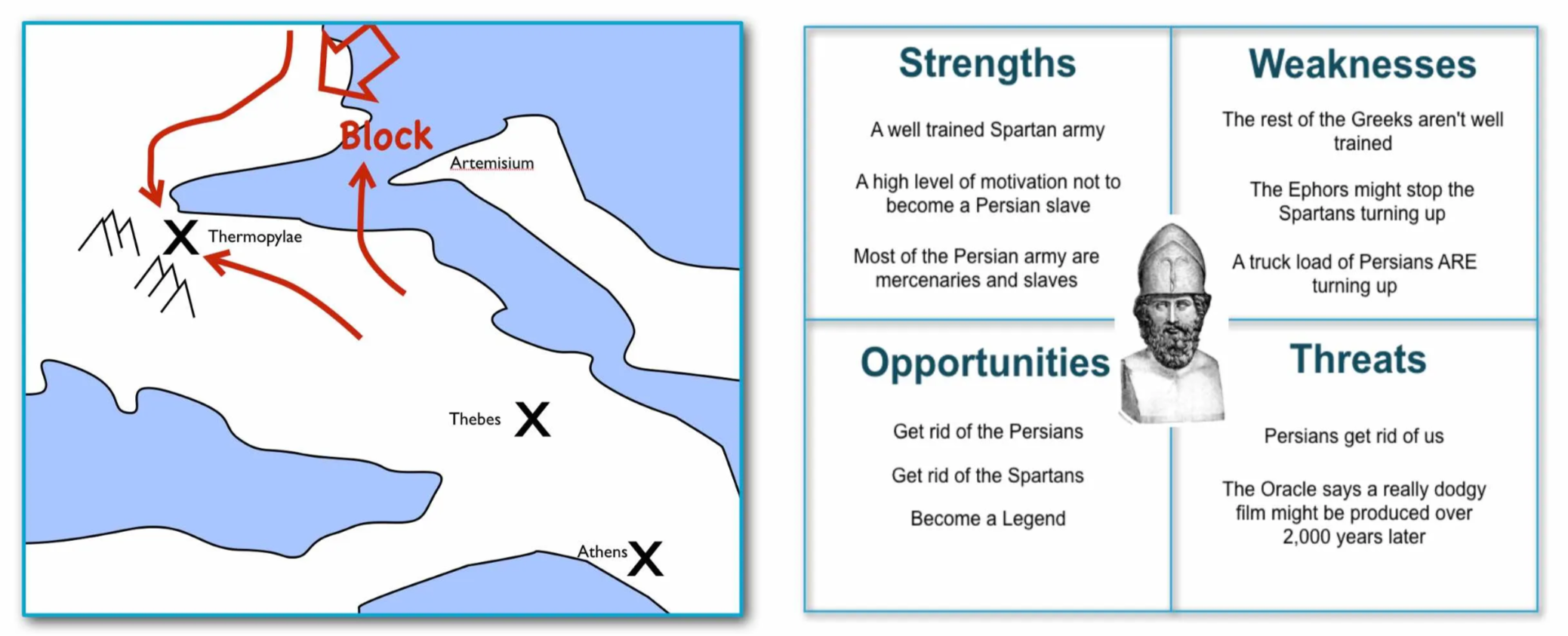Maps Beat SWOT
Maps beat SWOT every time. Maps show relationships and give you actionable intelligence. SWOT gives you categories but no tactical guidance.
Passage Details
What do you think would be more effective in combat — a strategy built upon an understanding of the landscape or a SWOT diagram? Which do you use in business? The wrong one.
This passage captures a fundamental insight about strategic thinking: landscape understanding beats abstract analysis every time. The contrast between tactical maps and SWOT matrices reveals why most business strategy fails.
The Combat Test
Imagine you're Themistocles preparing to defend against Xerxes' army. You have two options:
Option 1: A tactical map showing Thermopylae, Artemisium, Thebes, Athens - with specific geographical features, troop positions, and strategic relationships.
Option 2: A SWOT analysis with bullet points like "lots of Persians" and in abstract categories. "Narrow terrain" can't be identified without a map.

Left: A tactical map showing Thermopylae, Artemisium, Thebes, and Athens with specific geographical features, troop movements (red arrows), and strategic positions (naval blockade at Artemisium). Right: A SWOT analysis with abstract categories and bullet points about Persian forces and Greek capabilities.
Which would you choose? The answer is obvious: the map wins every time.
Why Maps Beat SWOT
1. Specificity Over Generality
- Map: Shows exactly where the narrow pass is, where naval forces can block, how land and sea strategies connect
- SWOT: You can't figure out "narrow terrain" like you can using a map
2. Spatial Relationships
- Map: Reveals how Thermopylae connects to Artemisium, how components work together
- SWOT: Treats everything as isolated factors in separate boxes
3. Actionable Intelligence
- Map: Lets you position forces, exploit chokepoints, coordinate operations
- SWOT: Gives you categories but no tactical guidance
4. Communication
- Map: Shows your team exactly where to stand, when to move, how to coordinate
- SWOT: Requires interpretation and translation into action
The Business Parallel
Most leaders use the equivalent of SWOT in their business:
- Generic frameworks (SWOT, Porter's Five Forces, etc.)
- Abstract analysis disconnected from their actual landscape
- Lists of factors without understanding relationships
Wardley Mapping is the business equivalent of that tactical map. It shows:
- Your actual value chain
- How components relate to each other
- Where you're positioned in the landscape
- What the terrain actually looks like
Strategic Implications
1. Stop Analyzing in the Abstract
Generic frameworks create the illusion of strategic thinking without providing actionable insights. They're like trying to navigate a battlefield with a list of bullet points instead of a map.
2. Map Your Actual Landscape
Your competitors, your value chain, your evolution stages - these are your Thermopylae and Artemisium. Map them, understand the terrain, and you'll make better strategic decisions.
3. Focus on Relationships
Maps show how components connect and influence each other. This is where strategic opportunities and threats emerge.
4. Communicate with Clarity
A map lets you show your team exactly what you're doing and why. No interpretation required.
The Key Insight
The map is not the territory, but it's a hell of a lot better than a list of bullet points.
Wardley Maps give you the business equivalent of that tactical map - they show your actual landscape, reveal relationships, and provide actionable intelligence. SWOT analysis gives you categories but no guidance.
Application to Strategy
When you understand your landscape through mapping, you can:
- See relationships between components that aren't obvious in matrices
- Identify tactical opportunities based on actual terrain, not abstract factors
- Communicate strategy with clarity and specificity
- Make decisions based on landscape understanding, not generic frameworks
Conclusion
The lesson is clear: stop using matrices and start using maps. Your business landscape is your battlefield. Map it, understand it, and you'll make better strategic decisions than any SWOT analysis could ever provide.
As Wardley would say: "The map is not the territory, but it's a hell of a lot better than a list of bullet points."
Frequently Asked Questions (FAQ)
Why do maps beat matrices?
Maps show relationships, specificity, and actionable intelligence. Matrices give you categories but no tactical guidance. Maps help you see the actual landscape; matrices keep you in the abstract.
What's wrong with SWOT analysis?
SWOT treats factors as isolated items in boxes, ignoring relationships and spatial context. It creates the illusion of strategic thinking without providing actionable insights.
How do Wardley Maps solve this problem?
Wardley Maps force you to identify your value chain, how components relate to each other, and where you're positioned in the landscape. They provide the business equivalent of a tactical map.
Why is landscape understanding so important?
Landscape understanding reveals relationships, opportunities, and threats that aren't visible in abstract analysis. It's the difference between navigating with a map versus navigating with a list of bullet points.